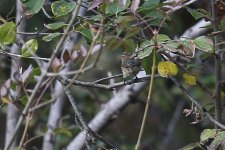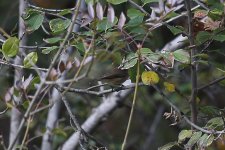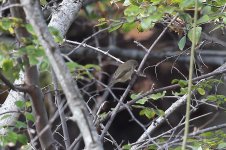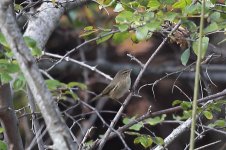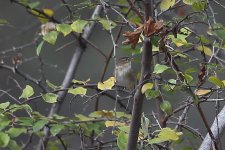-
Welcome to BirdForum, the internet's largest birding community with thousands of members from all over the world. The forums are dedicated to wild birds, birding, binoculars and equipment and all that goes with it.
Please register for an account to take part in the discussions in the forum, post your pictures in the gallery and more.
You are using an out of date browser. It may not display this or other websites correctly.
You should upgrade or use an alternative browser.
You should upgrade or use an alternative browser.
What is this spice...? (1 Viewer)
- Thread starter YesimV
- Start date
More options
Who Replied?Deb Burhinus
Used to be well known! 😎

Where abouts in Turkey? (The dark sullied flanks, generally dark appearance, short pp, olive fringes to secondaries and obvious white super points to Mountain Chiffchaff Phylloscopus sindianus I think)
Thank you for your answer. I took Bursa Karacabey in Turkey.Where abouts in Turkey? (The dark sullied flanks, generally dark appearance, short pp, olive fringes to secondaries and obvious white super points to Mountain Chiffchaff Phylloscopus sindianus I think)
Deb Burhinus
Used to be well known! 😎

This part of Turkey is not so Ok and the habitat of Karacabey is perhaps a bit strange so perhaps it has moved to lower hills for the winter?
Last edited:
Deb Burhinus
Used to be well known! 😎

some images here to compare
https://macaulaylibrary.org/asset/154072871
https://macaulaylibrary.org/asset/101683631
Ps Welcome to Birdforum!
https://macaulaylibrary.org/asset/154072871
https://macaulaylibrary.org/asset/101683631
Ps Welcome to Birdforum!
Last edited:
This part of Turkey is Ok but this habitat of Karacabey is perhaps a bit strange so perhaps it has moved to lower hills for the winter?
Mountain Chiffchaff up to this time had always seen to the east of Turkey. It is very valuable to see in the west. Thank you.
Deb Burhinus
Used to be well known! 😎

I have asked one of the moderators to move your question to the Identification forums because there you will have more answers
I am not an expert and I may have looked at a wrong map for this species so it is good to get other people’s views especially as this would be a ‘valuable’ record and a variant Common Chiffchaff needs to ruled out too.
I am not an expert and I may have looked at a wrong map for this species so it is good to get other people’s views especially as this would be a ‘valuable’ record and a variant Common Chiffchaff needs to ruled out too.
Last edited:
I have asked one of the moderators to move your question to the Identification forums because there you will have more answers
I am not an expert and I may have looked at a wrong map for this species so it is good to get other people’s views especially as this would be a ‘valuable’ record!
Thanks a lot
Hi Yesim and welcome aboard.
I've moved your threat to the Bird I D section of the Forum and have subscribed you to this thread so that you will get emails when suggestions are posted
Thanks a lot
Deb Burhinus
Used to be well known! 😎

Just to correct the taxonomy slip I made earlier I think this more likely to be a Caucasian (mountain) Chiffchaff lorenzii rather than Mountain Chiffchaff sindianus
(I also meant to say in addition to the dark brown tones/flanks and long white supercillium, note the strong looking black feet in your photo #5!)
https://erbirds.ru/v2taxon.php?s=369&l=en
(I also meant to say in addition to the dark brown tones/flanks and long white supercillium, note the strong looking black feet in your photo #5!)
https://erbirds.ru/v2taxon.php?s=369&l=en
Last edited:
Just to correct the taxonomy slip I made earlier I think this more likely to be a Caucasian (mountain) Chiffchaff lorenzii rather than Mountain Chiffchaff sindianus
(I also meant to say in addition to the dark brown tones/flanks and long white supercillium, note the strong looking black feet in your photo #5!)
https://erbirds.ru/v2taxon.php?s=369&l=en
I could not find Caucasian (mountain) Chiffchaff lorenzii? Plesae explane it more

Deb Burhinus
Used to be well known! 😎

I could not find Caucasian (mountain) Chiffchaff lorenzii? Plesae explane it more
Kafkas çıvgını, Kafkas Çıvgını (lorenzii)
Does this help?
https://avibase.bsc-eoc.org/species.jsp?avibaseid=A53FE02FD1C0A7FC
I’m not quite sure if it is still considered a sub-species of Mountain Chiffchaff so Phylloscopus sindianus lorenzii or a species in it's own right Caucasian Chiffchaff Phylloscopus lorenzii but the range of lorenzii is Eastern Turkey/Caucuses
https://www.picfair.com/pics/02217977-kaukasische-tjiftjaf-caucasian-chiffchaff-phyloscopus-lorenzii
whereas the nominate Mountain Chiffchaff sindianus is found in the Himalayas. They are very similar (Caucasian a bit darker).
https://tajikistan.birds.watch/v2taxon.php?s=311&l=en
Last edited:
Deb Burhinus
Used to be well known! 😎

I think this is the bird you're looking for: Mountain Chiffchaff
lol Delia, I really must turn to Opus more!
Thank you
Kafkas çıvgını, Kafkas Çıvgını (lorenzii)
Does this help?
https://avibase.bsc-eoc.org/species.jsp?avibaseid=A53FE02FD1C0A7FC
I’m not quite sure if it is still considered a sub-species of Mountain Chiffchaff so Phylloscopus sindianus lorenzii or a species in it's own right Caucasian Chiffchaff Phylloscopus lorenzii but the range of lorenzii is Eastern Turkey/Caucuses
https://www.picfair.com/pics/02217977-kaukasische-tjiftjaf-caucasian-chiffchaff-phyloscopus-lorenzii
whereas the nominate Mountain Chiffchaff sindianus is found in the Himalayas. They are very similar (Caucasian a bit darker).
https://tajikistan.birds.watch/v2taxon.php?s=311&l=en
Thank you very much for your help:t:
MJB
Well-known member
Kafkas çıvgını, Kafkas Çıvgını (lorenzii)
Does this help?
https://avibase.bsc-eoc.org/species.jsp?avibaseid=A53FE02FD1C0A7FC
I’m not quite sure if it is still considered a sub-species of Mountain Chiffchaff so Phylloscopus sindianus lorenzii or a species in it's own right Caucasian Chiffchaff Phylloscopus lorenzii but the range of lorenzii is Eastern Turkey/Caucuses
https://www.picfair.com/pics/02217977-kaukasische-tjiftjaf-caucasian-chiffchaff-phyloscopus-lorenzii
whereas the nominate Mountain Chiffchaff sindianus is found in the Himalayas. They are very similar (Caucasian a bit darker).
https://tajikistan.birds.watch/v2taxon.php?s=311&l=en
I suggest that these (or similar) are the preferable English names, whether informal or formal, because Caucasian Chiffchaff does have a relatively limited distribution whereas the Mountain Chiffchaff has a wide distribution distributed mainly along the Himalayas and in the huge area of high mountains of Central Asia. The two taxa are separated by at least 750 km. Raković et al 2019 note allopatry & the relatively low genetic divergence, but posit that both populations suffered genetic bottlenecks as the explanation.
MJB
Raković, M, JM Neto, RJ Lopes, EA Koblik, IV Fadeev, YV Lohman, SA Aghayan, G Boano, M Pavia, Y Perlman, Y Kiat, A Ben Dov, JM Collinson, G Voelker and SV Drovetski. 2019. Geographic patterns of mtDNA and Z-linked sequence variation in the Common Chiffchaff and the ‘chiffchaff complex’. PLoS ONE: 14(1): e0210268. doi.org/10.1371/journal.pone.0210268
CARERY
Well-known member
To ID Caucasian Chiffchaff in the field away from normal distribution range might not been as straightforward as one could hope. This is mainly because of the enormous variation Common Chiffchaff can show. As an example, a few years ago a potential Caucasian Chiffchaff has been caught in Germany but the DNA analysis proved it to be just a 'normal' Chiffchaff:
https://club300.de/gallery/photo1.php?id=55765 (use the little arrow in the right corner to see two more pics)
So, I'd rather let it fly as Chiffchaff (s)sp.
https://club300.de/gallery/photo1.php?id=55765 (use the little arrow in the right corner to see two more pics)
So, I'd rather let it fly as Chiffchaff (s)sp.
Deb Burhinus
Used to be well known! 😎

To ID Caucasian Chiffchaff in the field away from normal distribution range might not been as straightforward as one could hope. This is mainly because of the enormous variation Common Chiffchaff can show.
Hi Roland, thank you - Those images really prove your point!
Yes, as I indicated in #7, variants of Common Chiffchaff need to be ruled out- and I accept from you it is not 100% possible (I thought perhaps it was just me that wasn’t able to rule out Common Chiffchaff which was why I was hoping a more experienced voice could do so for me
However, just for arguments sake, it does tick all the visual boxes on structure and plumage for lorenzii to my eyes and when it’s a Chiffchaff with a genetically distinct plumage type with no known introgression, perhaps that works in it’s favour as does (overshooting?) short distant migration movements this time of year? I agree ‘Vagrancy’ demands extra scrutiny but it also isn’t blind nor deaf so presumably they can be identified on call with plumage?
So to conclude - To me this is very possibly a vagrant Caucasian lorenzii but unless it could have been identified by call, I wouldn’t like to say 100% given the ‘value’ of such a record and as Carey says, rather disappointingly for the OP, this must be left as a ‘Chiffchaff species’
MjB - thanks, I think I may have come across the same paper and learned a bit more about the taxonomy of Mountain/Caucasian Chiffchaff in the process.
“..the Mountain Chiffchaff P. sindianus can now be concluded to be divergent from all other taxa in at least one mitochondrial and one nuclear locus, to show plumage and vocal differences from other chiffchaffs and to overlap broadly in range with some populations of Common Chiffchaff without apparent hybridization or introgression in the Greater Caucasus and Transcaucasia, thereby fulfilling all the criteria of a ‘strict’ biological species. Several authorities treat P. s. sindianus and P. s. lorenzii as separate species (e.g. [3]), but this is not strongly supported by our genetic data.”
https://journals.plos.org/plosone/article?id=10.1371/journal.pone.0210268
Last edited:
Users who are viewing this thread
Total: 2 (members: 0, guests: 2)




